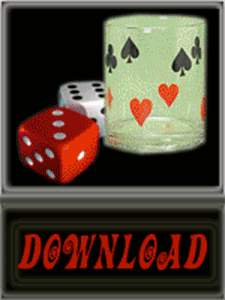Pokerwiner.com → Lessons of poker
ANALYSIS IN PRACTICE
To see how this sort of analysis works in practice, we’ll look at a couple of example.
Draw Poker
$5-$10 Limit





You





Opponent
You open for $5 in early position. Everyone fold except the player under the gun who originally checked to you and who now raises another $5.
We’ll assume you know this player will never make such a play without three-of-a-kind or better. We’ll also assume that with the antes and your implied odds it would be incorrect to fold even if you knew your opponent had a pat hand.
So the question is whether you should simply call the $5 raise or reraise another $5.
Your opponent’s raise tells you he has either trips, which must necessarily be smaller than your three aces, or a pat hand.
If he has trips, you have the best hand and are the favorite to win the pot; if he has a pat hand, you have the second-best hand and are an underdog to win the pot.
According to draw poker distribution, your opponent will have three-of-a-kind about 65 percent of the time an a pat hand about 35 percent of the time.
When he has a pat hand, you should obviously not reraise. However, it’s nearly 2-to-1 he has trips. Should you therefore reraise?
The answer is no because when you only call and your opponent draws cards, you can draw one card, as though you had two pair, an check-raise after the draw.
Assuming he calls your raise, which he will almost always do, and neglecting the slight chance of your opponent improving to a full house when you don’t, you win $30 (plus the antes) by playing this way - $10 before the draw and $20 afterward when you check, your opponent bets $10, and you raise to $20.
In contrast, by reraising $5 before the draw and coming out betting $10 afterward, you win a total of $25 - $15 before the draw and $10 afterward.
Thus, the 65 percent of the time your opponent has three-of-a-kind, you win $5 more by calling
instead of reraising. A the same time, the 35 percent of the time he has a pat hand (and you don’t improve to a full house), you lose only $10 instead of $15, a savings of $5.
Therefore, in this situation a call is the correct play since it is right all the time whether your opponent has
three-of-a-kind or a pat hand.
Here is a trickier situation from holdem:
Holdem
$10-$20 Limit (Small Pot)




Opponent You




Board
Your opponent, who is a good player poker, checked and called your bet on the flop. When the deuce falls, your opponent checks again. Should you check or bet your pair of kings?



